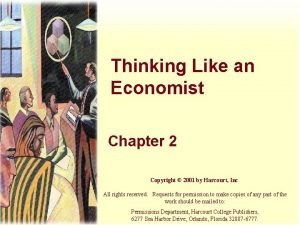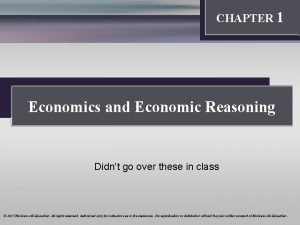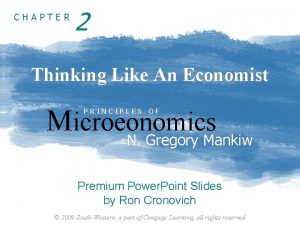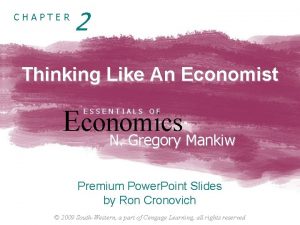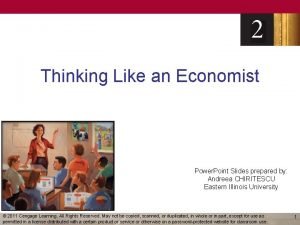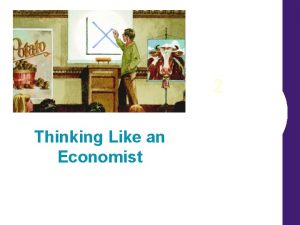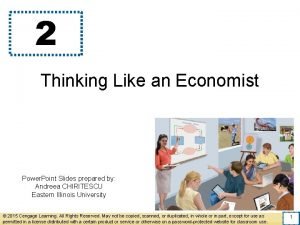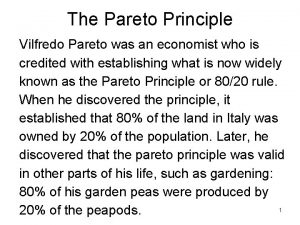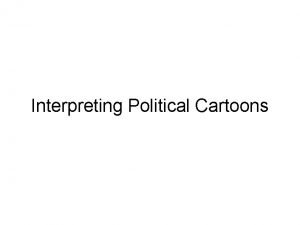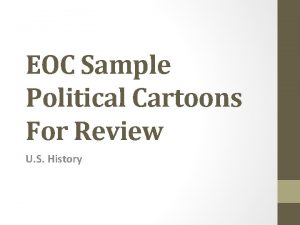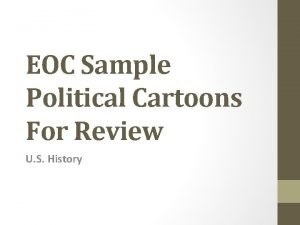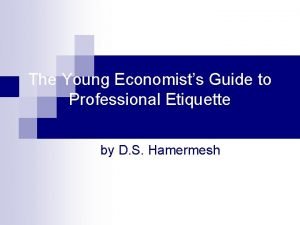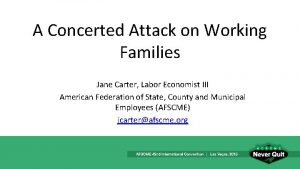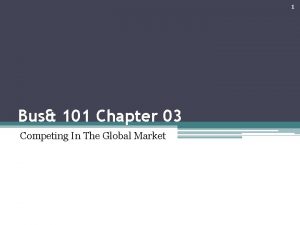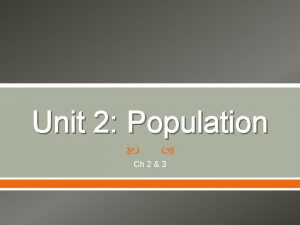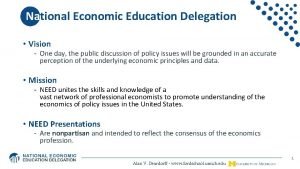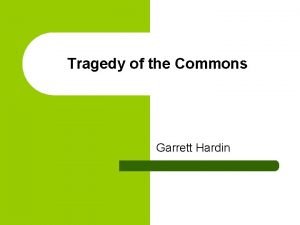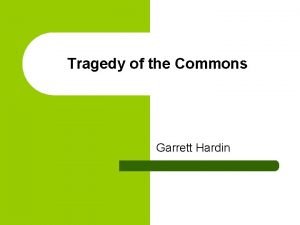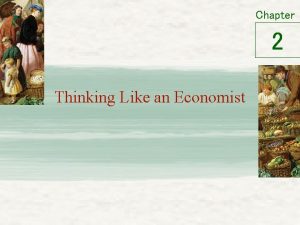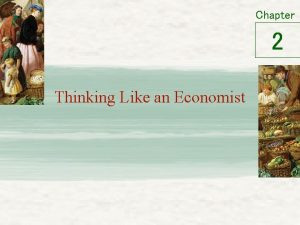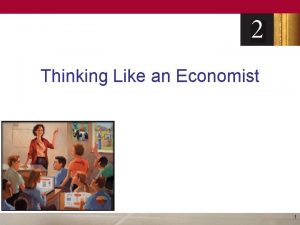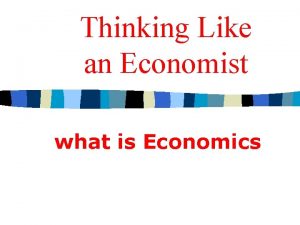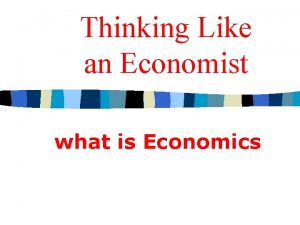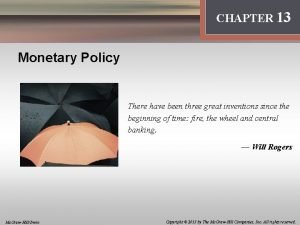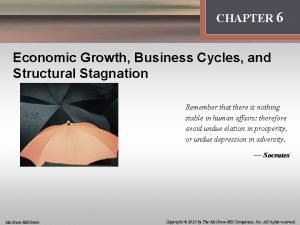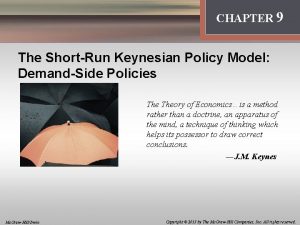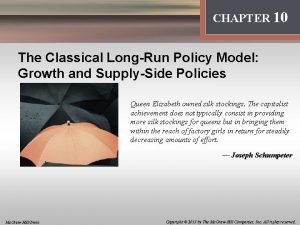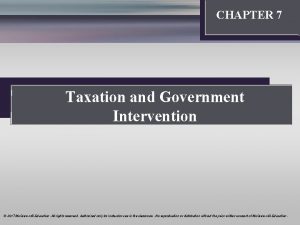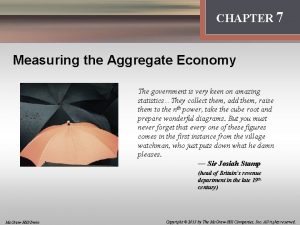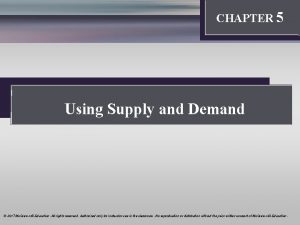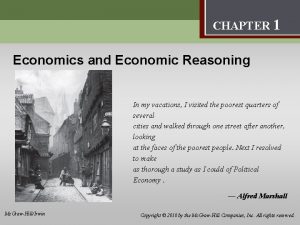Introduction Thinking Like an Economist 1 CHAPTER 1

















- Slides: 17

Introduction: Thinking Like an Economist 1 CHAPTER 1 Economics and Economic Reasoning In my vacations, I visited the poorest quarters of several cities and walked through one street after another, looking at the faces of the poorest people. Next I resolved to make as thorough a study as I could of Political Economy. — Alfred Marshall Mc. Graw-Hill/Irwin Copyright © 2010 by the Mc. Graw-Hill Companies, Inc. All rights reserved.

Introduction: Thinking Like an Economist 1 Chapter Goals • Define economics • Examine three coordination problems all economies must solve • Explain how to make decisions by comparing marginal costs and marginal benefits • Define opportunity costs and explain its relationship to economic reasoning 1 -2

Introduction: Thinking Like an Economist 1 Chapter Goals • Explain real-world events in terms of: • Economic forces • Social forces • Political forces • Distinguish between: • Microeconomics and macroeconomics • Positive economics, normative economics, and the art of economics 1 -3

Introduction: Thinking Like an Economist 1 What Economics Is Economics is the study of how human beings coordinate their wants and desires, given the decision-making mechanism, social customs, and political realities of the society • The three central coordination problems any economy must solve: 1. What, and how much, to produce 2. How to produce it 3. For whom to produce it 1 -4

Introduction: Thinking Like an Economist 1 Modern Economics • Economics, like any field of study, evolves and changes • Modern economics is based both on deduction and induction • Deduction is a method of reasoning in which one deduces a theory based on a set of almost self-evident principles • Induction is a method of reasoning in which one develops general principles by looking for patterns in the data • Abduction is the combination of deduction and induction 1 -6

Introduction: Thinking Like an Economist 1 Marginal costs and marginal benefits • Using economic reasoning, decisions are often made by comparing marginal costs and marginal benefits • Marginal cost is the additional cost over and above costs already incurred • Marginal benefit is the additional benefit above and beyond what has already accrued 1 -8

Introduction: Thinking Like an Economist 1 Marginal costs and marginal benefits The economic decision rule: • If the marginal benefits of doing something exceed the marginal costs, do it. MB > MC Do it! • If the marginal costs of doing something exceed the marginal benefits, don’t do it. MC > MB Don’t do it! 1 -9

Introduction: Thinking Like an Economist 1 Opportunity Cost • Opportunity cost is the benefit forgone of the next-best alternative to the activity you have chosen • Opportunity cost should always be less than the benefit of what you have chosen • Opportunity cost is the basis of cost/benefit economic reasoning 1 -10

Introduction: Thinking Like an Economist 1 Opportunity Cost Examples of opportunity cost: 1. Individual decisions • The opportunity cost of college includes: • Items you could have purchased with the money spent for tuition and books • Loss of the income from a full-time job 2. Government decisions • The opportunity cost of money spent on the war on terrorism is less spending on health care or education 1 -11

Introduction: Thinking Like an Economist 1 Economic and Market Forces • Economic forces are mechanisms that ration scarce goods • A market force is an economic force that is given relatively free rein by society to work through the market • The invisible hand is the price mechanism that guides our actions in a market. The invisible hand is an example of a market force. • If there is a shortage, prices rise • If there is a surplus, prices fall 1 -12

1 Introduction: Thinking Like an Economist The Invisible Hand Theory • According to the invisible hand theory, a market economy, through the price mechanism, will allocate resources efficiently • Prices fall when quantity supplied is greater than quantity demanded • Prices rise when the quantity demanded is greater than the quantity supplied • Efficiency means achieving a goal as cheaply as possible 1 -17

Introduction: Thinking Like an Economist 1 Microeconomics and Macroeconomics • Economic theory is divided into two parts; • Microeconomics is the study of individual choice, and how that choice is influenced by economic forces • Macroeconomics is the study of the economy as a whole 1 -18

Introduction: Thinking Like an Economist 1 Microeconomics and Macroeconomics • Microeconomics studies such things as: • The pricing policy of firms • Household’s decisions on what to buy • How markets allocate resources among alternative ends • Macroeconomics studies such things as: • Inflation • Unemployment • Economic growth 1 -19

Introduction: Thinking Like an Economist 1 Economic Policy Options Objective Policy Analysis • To distinguish between objective and subjective analysis, economics is divided into three categories 1. Positive economics is the study of what is 2. Normative economics is the study of what should be 3. Art of economics is using the knowledge of positive economics to achieve the goals determined in normative economics 1 -22

Introduction: Thinking Like an Economist 1 Chapter Summary • Three coordination problems are what to produce, how to produce it, and for whom to produce it • Scarcity exists • Modern economists use abduction • Economic reasoning structures all questions in a cost/benefit framework • Opportunity costs exist 1 -23

Introduction: Thinking Like an Economist 1 Chapter Summary • Economic, political, and social forces are always at work • Under certain conditions, the market, through the price mechanism, will allocate scarce resources efficiently • Economics is divided into micro and macroeconomics • Precepts are the guides for policies based on theorem • Economics can be subdivided into positive economics, normative economics, and the art of economics 1 -24

Introduction: Thinking Like an Economist 1 Preview of Chapter 2: The Production Possibility Model, Trade, and Globalization • Demonstrate opportunity cost with a production possibility curve • Discuss the increasing marginal opportunity cost • Relate the concept of comparative advantage to the production possibility curve • Show through comparative advantage and trade, a country can consume beyond their production possibility • Explain how globalization and outsourcing are part of a global process guided by the law of one price 1 -25
 Thinking like an economist chapter 2
Thinking like an economist chapter 2 Thinking like an economist chapter 1
Thinking like an economist chapter 1 Chapter 2 thinking like an economist summary
Chapter 2 thinking like an economist summary Chapter 2 thinking like an economist
Chapter 2 thinking like an economist Thinking like an economist chapter 2
Thinking like an economist chapter 2 Thinking like an economist summary
Thinking like an economist summary Thinking like an economist ppt
Thinking like an economist ppt Lower outer fence
Lower outer fence A wise economist asks a question
A wise economist asks a question Sample of political cartoon
Sample of political cartoon What does the cartoon imply about the open door policy
What does the cartoon imply about the open door policy The young economist's guide to professional etiquette
The young economist's guide to professional etiquette Jane carter labor economist
Jane carter labor economist Economist.com
Economist.com Economist.com
Economist.com Economist china trade
Economist china trade Tradgedy of the commons
Tradgedy of the commons Tragedy of commons examples
Tragedy of commons examples
